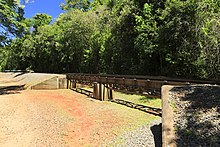Door Ecológico de la Selva
| Tren Ecológico de la Selva Tren de las Cataratas |
|||||||||||||
|---|---|---|---|---|---|---|---|---|---|---|---|---|---|
|
Rainforest Ecology Railway or Waterfall Railway
| |||||||||||||
|
Route
| |||||||||||||
| Route length: | 7 km | ||||||||||||
| Gauge : | 600 mm ( narrow gauge ) | ||||||||||||
| Minimum radius : | 37 m | ||||||||||||
|
|||||||||||||
The Tren Ecológico de la Selva (Ecological Rainforest Train) or Tren de las Cataratas (waterfalls-Bahn) is a built in 2001 and seven kilometers long hiking - narrow-gauge railway with a track width of 600 mm in the Iguazú National Park in the province of Misiones in Argentina .
business
The route connects the visitor center of the national park with two access points to the waterfalls . There are several push-pull train units which, thanks to several intersections and the double-track section , can run between the visitor center and Cataratas train station at the same time. Each train can carry up to 150 passengers from the visitor center via Cataratas (waterfalls) station to Garganta del Diablo (Devil's Gorge) station. The transport volume is around 900,000 passengers per year.
The locomotives and wagons were built in England by Alan Keef Ltd in Ross-on-Wye . They are painted green, and each train consists of a propane gas locomotive and up to five open-sided, four-axle cars with wooden seats, from which the passengers have direct contact with the forest.
The tracks run along the Río Iguazú . The journey takes about 25 minutes at a speed of up to 20 km / h. In times of high visitor numbers, operations in the Cataratas train station are suspended. From the Garganta del Diablo train station (Devil's Gorge), a footbridge about 600 meters long leads over the Río Iguazú above the falls to a viewing platform at the edge of the 90-meter-high Garganta del Diablo waterfall.
Rail vehicles
The trains run as push-pull trains , the locomotives usually run on the Garganta del Diablo side. The wagon trains usually consist of three to five passenger cars. The two-axle locomotives of the type K80 by Alan Keef are equipped with a with liquefied gas-fueled equipped Ford Motor CSG 649, of 60 kW at 2000 min -1 making. The noise level of 70/80 decibels (measured at a distance of one meter) is not exceeded.
The wheelchair-accessible, semi-open carriages each have 42 to 50 seats.
Two battery locomotives are now also in use.
Track construction
Each 7.50 m long Decauville splints with a track width of 600 mm are from South Africa, and have a weight per meter of 15 kg / m. The minimum radius is 37 m. The sleepers measure 1.20 × 0.10 × 0.12 m, they are made of Quebracho Colorado hardwood and are laid 0.85 m apart. There are 17 bridges under which both water and wild animals can cross under the railway ( amphibious passages and biotope network underpasses).
Individual evidence
- ^ Ecological Rainforest Train.
- ↑ a b Tren Ecológico de la Selva - Un poco de Historia.
- ↑ La primera locomotora turística 100% ecológica en las Cataratas del Iguazú. August 5, 2017. Retrieved February 4, 2020.
- ↑ El Tren de la Selva en el Parque Nacional Iguazú cuenta con nuevos vagones. June 19, 2019. Retrieved February 4, 2020.
Coordinates: 25 ° 40 ′ 42.9 ″ S , 54 ° 27 ′ 11.5 ″ W.


